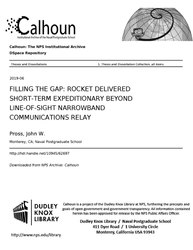File:FILLING THE GAP- ROCKET DELIVERED SHORT-TERM EXPEDITIONARY BEYOND LINE-OF-SIGHT NARROWBAND COMMUNICATIONS RELAY (IA fillingthegaproc1094562697).pdf

Original file (1,275 × 1,650 pixels, file size: 10.63 MB, MIME type: application/pdf, 252 pages)
Captions
Captions
Summary[edit]
| FILLING THE GAP: ROCKET DELIVERED SHORT-TERM EXPEDITIONARY BEYOND LINE-OF-SIGHT NARROWBAND COMMUNICATIONS RELAY
( |
||
|---|---|---|
| Author |
Pross, John W. |
|
| Title |
FILLING THE GAP: ROCKET DELIVERED SHORT-TERM EXPEDITIONARY BEYOND LINE-OF-SIGHT NARROWBAND COMMUNICATIONS RELAY |
|
| Publisher |
Monterey, CA; Naval Postgraduate School |
|
| Description |
The current Department of Defense (DoD) satellite communications (SATCOM) network consists of large, exquisite, and expensive constellations providing service across the radio frequency spectrum. However, the current SATCOM architecture is vulnerable to adversary actions including interference, jamming, directed energy, and antisatellite weapons. Despite the rise in adversary threats, the DoD continues to grow more reliant on SATCOM services in execution of all seven joint warfighting functions. The Marine Corps Operating Concept acknowledges that traditional beyond line-of-sight (BLOS) communications capabilities will be severely degraded or non-existent in the future fight. This research demonstrates a near-term solution that increases resiliency in BLOS communications consisting of a rocket-delivered expeditionary narrowband radio relay with an applicable use case. The payload of the relay consists of a software-defined radio controlled by a single-board computer and demonstrates resiliency by cross-banding signals between very high frequency and ultra high frequency transmit and receive frequencies, respectively. After a rigorous design and test process, this research culminated with an actual demonstration over the air and an attempted delivery by an actual rocket to a target altitude of 30,000 feet. Subjects: expeditionary; rocket; payload; satellite communications; software defined radio; raspberry pi; narrowband communications; Marine Corps Operating Concept; resiliency |
|
| Language | English | |
| Publication date | June 2019 | |
| Current location |
IA Collections: navalpostgraduateschoollibrary; fedlink |
|
| Accession number |
fillingthegaproc1094562697 |
|
| Source | ||
| Permission (Reusing this file) |
This publication is a work of the U.S. Government as defined in Title 17, United States Code, Section 101. Copyright protection is not available for this work in the United States. | |
Licensing[edit]
| Public domainPublic domainfalsefalse |
This work is in the public domain in the United States because it is a work prepared by an officer or employee of the United States Government as part of that person’s official duties under the terms of Title 17, Chapter 1, Section 105 of the US Code.
Note: This only applies to original works of the Federal Government and not to the work of any individual U.S. state, territory, commonwealth, county, municipality, or any other subdivision. This template also does not apply to postage stamp designs published by the United States Postal Service since 1978. (See § 313.6(C)(1) of Compendium of U.S. Copyright Office Practices). It also does not apply to certain US coins; see The US Mint Terms of Use.
|
 | |
| This file has been identified as being free of known restrictions under copyright law, including all related and neighboring rights. | ||
https://creativecommons.org/publicdomain/mark/1.0/PDMCreative Commons Public Domain Mark 1.0falsefalse
File history
Click on a date/time to view the file as it appeared at that time.
| Date/Time | Thumbnail | Dimensions | User | Comment | |
|---|---|---|---|---|---|
| current | 12:28, 20 July 2020 |  | 1,275 × 1,650, 252 pages (10.63 MB) | Fæ (talk | contribs) | FEDLINK - United States Federal Collection fillingthegaproc1094562697 (User talk:Fæ/IA books#Fork8) (batch 1993-2020 #16436) |
You cannot overwrite this file.
File usage on Commons
The following page uses this file:
Metadata
This file contains additional information such as Exif metadata which may have been added by the digital camera, scanner, or software program used to create or digitize it. If the file has been modified from its original state, some details such as the timestamp may not fully reflect those of the original file. The timestamp is only as accurate as the clock in the camera, and it may be completely wrong.
| Short title | FILLING THE GAP: ROCKET DELIVERED SHORT-TERM EXPEDITIONARY BEYOND LINE-OF-SIGHT NARROWBAND COMMUNICATIONS RELAY |
|---|---|
| Image title | |
| Author | Pross, John W. |
| Software used | Pross, John W. |
| Conversion program | Adobe PDF Library 11.0 |
| Encrypted | no |
| Page size |
|
| Version of PDF format | 1.4 |

